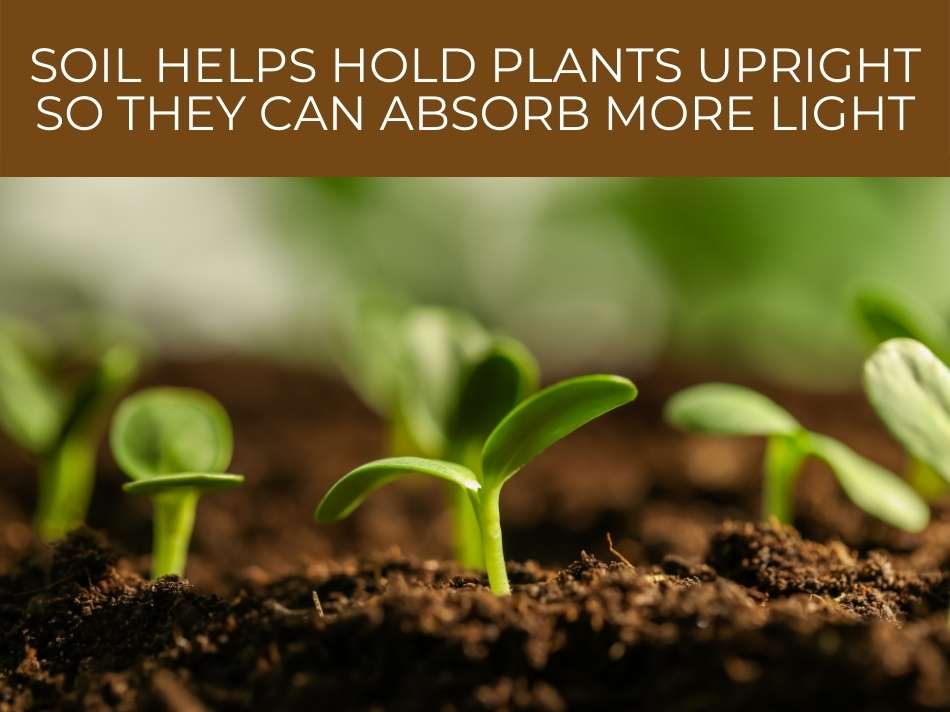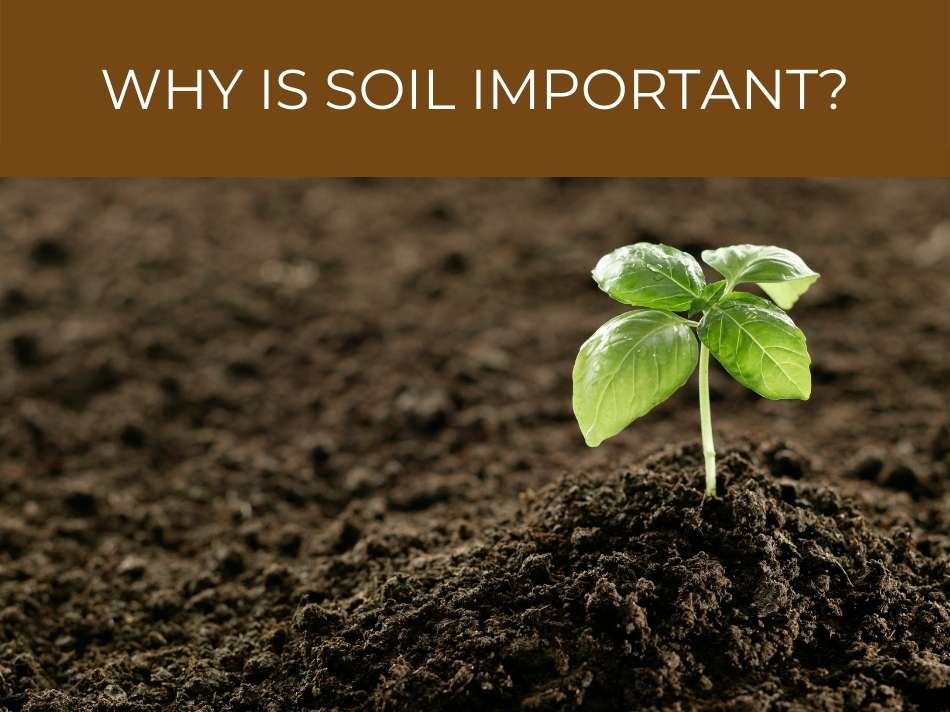Have you ever wondered about the relationship between plants and soil? We know that most plants grow in it, but what does soil actually do? How does it keep the greenery all around us thriving?
Soil serves 3 functions. It acts as an anchor to root plants and keeps them upright. It provides their root systems with water, and it feeds them vital nutrients and minerals. In addition, soil plays a role in feeding oxygen to plants.
To better understand how beneficial soil is for plants, it’s necessary to look at what it comprises. Various soil types also have different capabilities in terms of water retention and mineral content, which can impact a plant’s growth.

How Does Soil Help Plants?
Soil is made up of organic matter and essential minerals.

Soil helps plants though the combination of organic matter & minerals that provides essential nutrients. Soil also holds water, which transports these components through plants’ root systems & into their stems and leaves. Plus, soil helps hold plants upright so they can absorb more light.
Soil is a complex system with plenty of moving parts that directly impact how well your plants will grow.
As plants and various microorganisms decay, they break down into the soil and become a rich food source.
A combination of decaying animal matter and plant matter is called humus, which becomes the food bacteria feeds on deep inside the earth.
These bacteria transform humus into plant nutrition.
Similarly, but over the course of hundreds of years, rocks erode and disintegrate from weathering and become the minerals that live in the ground.
Minerals help plants develop hardy roots and stems and equip them to flower.
Furthermore, organic matter and minerals also separate soil particles to make room for oxygen, which plants need just as much as water and food.

Why is Soil Important?
This seems obvious, but without soil, plants would fall over.
It provides a much-needed anchor for their roots and gives them somewhere to grow.
Soil is also important because it serves as the medium through which we feed our plants.

Soil is important because it provides plants with nutrients for growth, and prevents flooding by absorbing water. Soil also anchors plants in the ground, so they can grow vertically to absorb more sunlight. Plants obtain essential nutrients from soil.
Roots draw nutrients and minerals, along with water and oxygen, out from the soil and feed them to the rest of the plant so that it can grow.
That being said, the relationship between soil and plants is mutually beneficial.
Soil is only rich in nutrients because of plant matter decaying over time, after which it is broken down and turned into food for new plants and other microorganisms.
Of course, soil is also the vessel to which we add water, which contains oxygen, for roots to absorb.
Regarding water, good quality soil can regulate how much water is retained and how much is discharged, which plays an essential role in plant health.
See how amazing rainforest soil is.

How Does Soil Affect Plant Growth?
Soil can be make-or-break for plants.
If it is infertile, your plants won’t receive the nutrients they need to thrive.

Without good soil, plants will struggle to grow. They may start producing small leaves, show no flowers, or simply not produce any new growth at all. In worst-case scenarios, the wrong soil can prevent your greenery from receiving any nutrients, at which point plants will perish.
Cloggy, non-aerated soil is also problematic and can prevent roots from doing their job of transporting food and water to leaves and stems.
Each soil particle stores both oxygen and water.
This reduces evaporation and ensures your plants have a steady supply of these life-preserving necessities.
Stored water also cools your plants as it evaporates, maintaining their carefully constructed cells and tissue.
A plant needs healthy and sizeable cells to photosynthesize.
By the same token, soil also acts as an insulator, protecting roots from drastic fluctuations in temperature that could otherwise wreak havoc on your plants.
Therefore, it is safe to say that soil directly impacts plant growth.
See the most common soil problems & how to fix them.

Do Plants Need Soil?
Not all plants need soil, although plenty of them prefer it.
Many species can be grown in hydroponic systems, which emulate the nutrient-rich environments we generally associate with fertile soil.
While plants can live without soil, they cannot live without the oxygen, nutrients, minerals, and moisture that soil provides. To successfully grow plants without soil, plants must obtain those requirements elsewhere–either through air (i.e., aeroponically) or water (i.e., hydroponically).
In short, hydroponics are growing systems where the chief source of food for plants in nutrient-rich water.
Plants are rested or suspended in growing mediums other than soil, like pine bark or coco coir.
Their roots are given direct access to water reservoirs, which contain H2O that has been treated with supplemental nutrients and minerals.
For hydroponics to work successfully, however, plants also need exposure to specific light and humidity levels.
There are also other instances of plants growing without soil, like, for example, air plants.
These wonders draw their nutrition from moisture in the air.
There are, of course, also a range of plants that are just more practical to grow in soil.
Crops like corn, for example, have long-reaching roots that don’t adapt very well to hydroponics.
If you’re fortunate enough to live in a spot with good weather and fertile soil, you’ll likely find it incomparable.
After all, the soil-plant relationship is a natural adaptation that has been around since time immemorial.
Find out if you can grow anything with hydroponics.

Is Soil Living?
Soil is a complex natural masterpiece full of living microorganisms.
Although soil is not alive, it contains countless multitudes of microorganisms. It is constantly changing & growing as a result of the ecosystem that lives inside it. Living plants, living microorganisms, bugs, bacteria, and fungi all form a collective called soil organisms.
Like other living things, soil needs oxygen and water to stay healthy and fertile.
Not only does soil contain a world of its own, but it also provides support to other living things.
The most obvious of these are plants, but did you know that soil is also full of living organisms like isopods, springtails, worms, bacteria, and fungi?
Each of these plays a particular role in keeping soil healthy so that it can do its job of feeding and rooting plants.
Soil has four distinct layers.
It has a top layer that contains leaf litter and decaying plant and animal matter that breaks down and turns into nutrients.
A second layer is called topsoil, which is where roots do most of their growing.
Topsoil also houses bacteria and fungi, both good and bad, and holds water for oxygen and hydration.
Below topsoil, there is a layer called tough soil, which is lighter in color but denser.
This layer accumulates from compounds and minerals that seep and travel downwards.
Even further down, beneath the tough soil, a compacted layer comprises mainly of weathered rock, which contains less life than the layers above it.
Right beneath is all; we find bedrock.

Conclusion
Soil is wonderful, complicated, and infinitely necessary for plants to grow and thrive.
Once you start investigating the thousands of tiny processes occurring in soil every day, you’ll soon see just how intricate it actually is and how much goes into priming it for successful plant growth.

